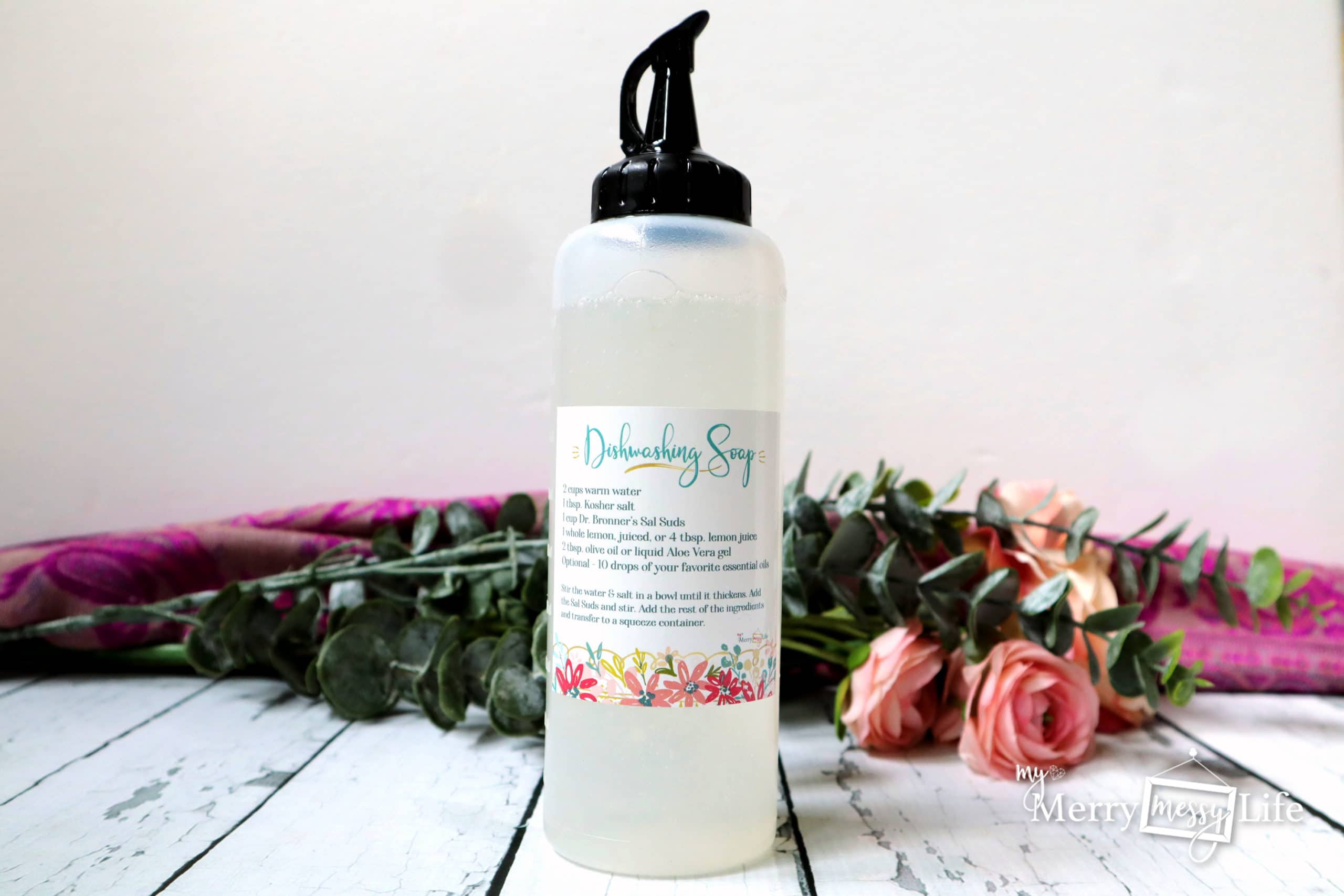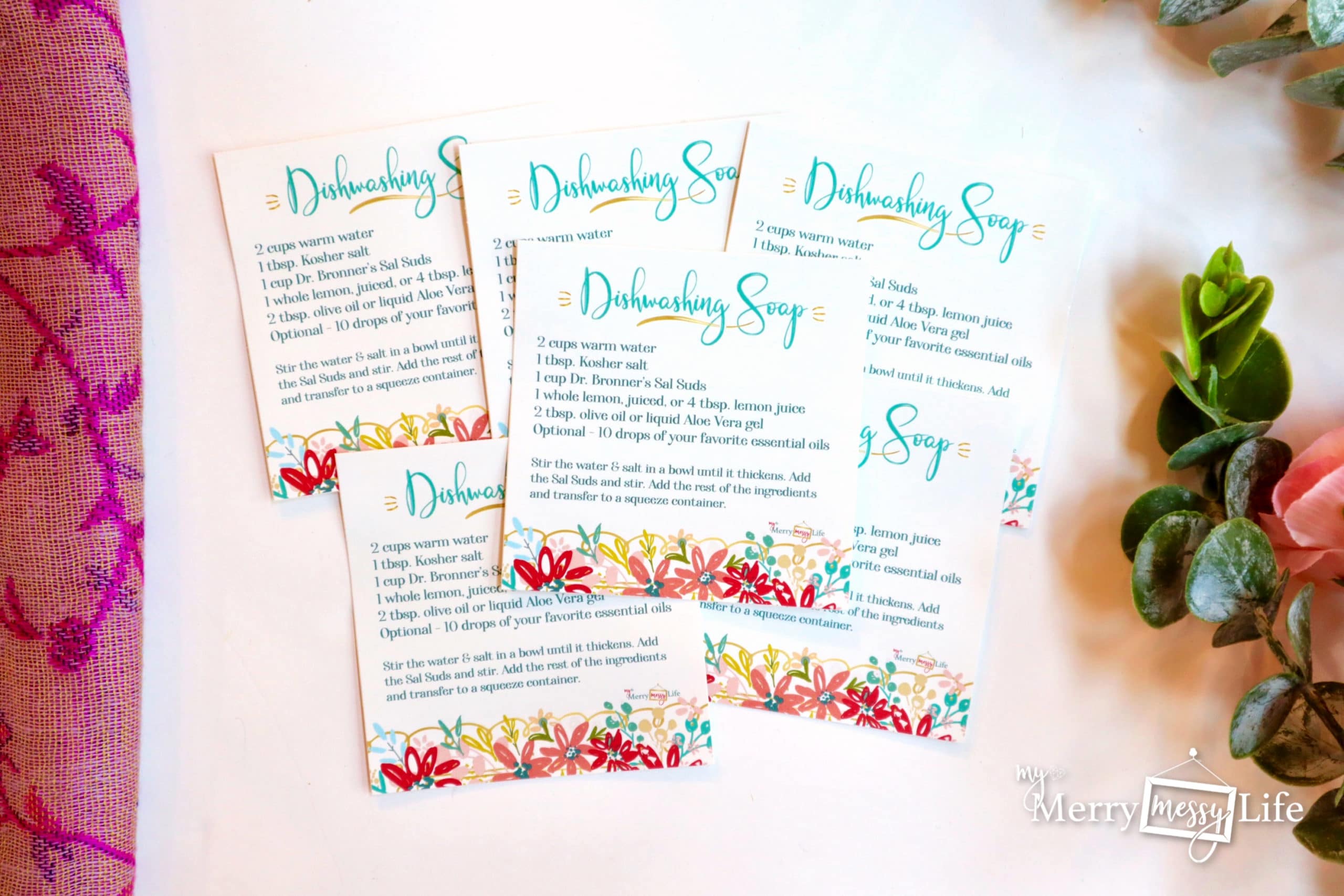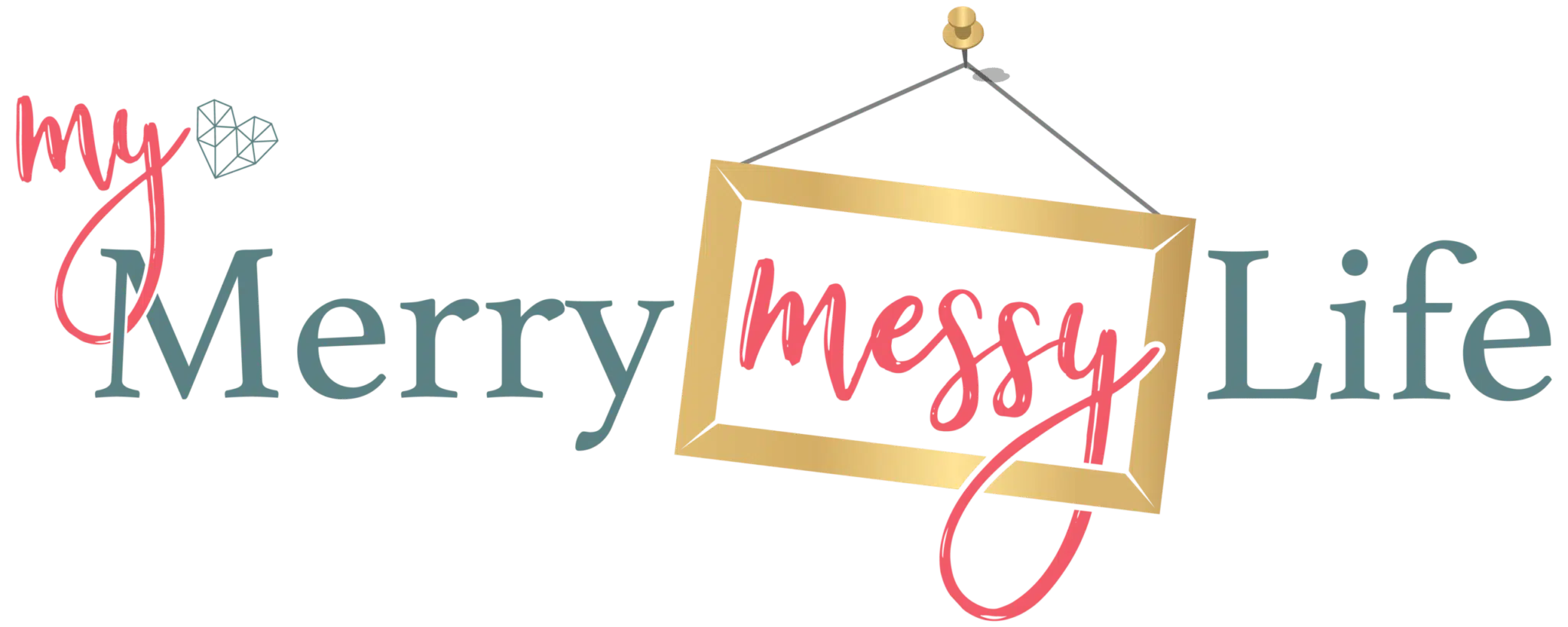It’s Easy to Make this Natural Dishwashing Soap at Home
Here's a natural dishwashing soap recipe using just water, salt, Dr. Bronner's Sal Suds, and lemon juice. No toxins in sight! I've finally found a dishwashing soap recipe that performs like store-bought soaps. This is a liquid dish soap that you use for hand-washing dishes.

Top 10 Cleaning and Laundry Recipes
This recipe is part of a 10-part series of natural cleaning and laundry recipes. You can find a list of all of the recipes here. This natural fabric stain remover recipe is also found in my book, Detox Your Home, which you can find on Amazon. It includes more than 80+ recipes, research and lists for natural products you can purchase all to help you go natural in your home!
Toxins in Dishwashing Soaps
Surfactants
Traditional dishwashing soaps like Dawn, Palmolive, Ivory, and Ajax all contain surfactants (detergents) that cause acute aquatic toxicity. What does this mean? It goes down our drains and harms fish, turtles, lizards, ducks, geese, and other aquatic life.
There are so many chemicals going down our toilets, sinks, bathtubs, and showers that sewage processing facilities are having difficulty removing them. I like to do my part to take care of our planet, and if I can make my own dishwashing detergent for just a few minutes once a month or so to do that, then I'm happy to! What an easy way to keep us and our planet cleaner and healthier.
Artificial Fragrances
I've written about the dangers of artificial fragrances many times here on the blog! Artificial fragrances can trigger asthma attacks, worsen allergies, and cause inflammation in the sinuses that can lead to more frequent colds and respiratory infections. Yikes! That's why I prefer to scent my homemade products with essential oils.
Fake fragrances disperse particles of formaldehyde and phthalates (thy-lates) into the air. Phthalates are small particles of plastic that are used to bind the artificial fragrance molecules together. We then breathe in those tiny particles of plastic, and they get into our nose and lungs – yuck!
Artificial Fragrance is a class of 3,000 different Chemicals
The term “artificial fragrance” stands for more than 3,000 chemicals and companies do not have to disclose which chemicals are included. So there’s no way of knowing if the chemicals in the product are safe for our health or not. I don’t know about you, but I’d rather be safe than sorry.
Why Make Your Own?
Because natural dishwashing soap recipes on the market are pretty pricey. If you buy a gallon of Dr. Bronner's Sal Suds (buy here on Amazon), you can really save money over time. Plus, it's more convenient! As soon as you run out, you already have the ingredients to refill it at home. You won't need to make sure to put it on the grocery list or be annoyed and out of luck when you run out.
Another reason is because you know every single ingredient in the bottle! You'll know it's non-toxic and safe for your whole family.
The last reason is because you can customize your scent with essential oils, or make it unscented if you prefer. This makes it more fun!
DIY Natural Dishwashing Soap Recipe
Make your own homemade dishwashing soap with this super simple recipe!
- Prep Time: 3 mins
- Total Time: 3 mins.
Ingredients
- 2 cups warm water
- 1 tbsp. kosher salt
- 1 cup Dr. Bronner's Sal Suds
- 4 tbsp. lemon juice, or 1 whole lemon juiced
- Optional – 2 tbsp. Olive Oil Sweet Almond Oil, or Grapeseed Oil or Liquid Aloe Vera Gel (to moisturize the hands)
- Optional – 10 drops of your favorite essential oils – I suggest Citrus Fresh, Thieves, Lemon, Orange, or Grapefruit, or Pine
- 24 oz. squeeze container or old dishwashing soap container (reuse an old one)
- Waterproof, vinyl recipe label for your bottle (never have to look up the recipe again!)
Instructions
Put the salt and water into a bowl and stir until dissolved. Add the Sal Suds and stir until it becomes thick and creamy! Add the rest of the ingredients and transfer to the container.
Notes
The kosher salt in this recipe is essential for making the soap thick, like store-bought detergents. Without it, your soap will be watery and hard to use! And kosher salt is important – other kinds of salt will not have the same effect (I tried them :)).
Get a Waterproof, Vinyl Label in My Etsy Shop!
You can purchase the recipe label in my Etsy shop. The labels are professionally printed on vinyl, waterproof paper. Having the label on the bottle means you never have to look up the recipe again!
- Get the natural dishwashing soap recipe label by itself here
- Or get a set of printable 10 cleaning and laundry recipe labels here

A Note About Dr. Bronner’s Sal Suds
In the natural world, we have vilified Sodium Laureth Sulfate. We say it’s a carcinogen and highly toxic to aquatic life. In most cases, this is true. But did you know that not all SLS is created equal? It depends on how it’s processed.
Check out Dr. Bronner’s Sal Suds rating on the EWG.org – it gets a perfect score! Totally nontoxic and safe.
According to this article,
Sodium Lauryl Sulfate (SLS) is a surfactant that cuts grease and dirt, generates copious suds, and biodegrades quickly and completely. SLS is made by combining a sulfate group with lauryl alcohol from coconut oil, then attaching sodium. If improperly formulated, SLS can irritate skin, but our superb formula uses coco-betaine and lauryl glucoside to counter this.
Also note that SLS is not a body care product. I would not use it in my homemade body washes or hand soaps unless you’re actually washing car grease or motor oil off of your hands! And definitely don’t use it in your hair – most shampoos in the stores contain SLS and they really dry out and then damage the hair.
It is meant to clean objects – like clothes, the kitchen, bathrooms, cars, etc.
Would You Rather Buy than Make?
Would you rather buy than make your own natural dishwashing soap recipe? That's fine, too! Here's what I love and can recommend.
- Seventh Generation Free and Clear Liquid Dish Soap
- Puracy Liquid Dish Soap
- Better Life Natural Dish Soap
Get Waterproof, Vinyl Labels from my Etsy shop
I designed and then had recipe labels professionally printed to make our lives easier! When you go to refill the bottle or jar, you don’t have to look up the recipe again. It’s printed on the label itself! These are waterproof, vinyl stickers that are high quality and do not pucker or come off even if they get wet.
- Get just the natural Dishwashing Soap label here
- Get a set of 10 cleaning and laundry sticker labels here

With what can i substitute Dr.Bronner’s Sal Sude.
I can not buy it in my place evev through Amazon.
Thanks and regards.
George
Hi George! Well, you could replace it with Castile Soap, it just won’t have as many bubbles.
Castile soap contains Palm Oil which is destroying the rain forest in Indonesia and the Amazon.
Hmm, I’m not aware of it containing palm oil, just olive oil.
You can find sustainably sourced palm oil.
Hi George! You could substitute with Castile Soap, it just won’t be as soapy or sudsy. You can also buy Sal Suds directly through Dr. Bronner’s website if that works better for you.
Hello there! If it comes out a lil on the soupy side, could I add more kosher salt to thicken it up?
Hi LeeAnna! I have tried that myself and it didn’t work to thicken it up. You could try heating it up and adding more salt to it, or use some of it first, then add some salt water to it and see if that works.
Sara,
This is the first time I have happened upon your site. I found your information insightful. I too, am unable to find Sal Sude, and will be using castile soap. As I am new to homemade products, how much of this product would I use per load of dishes? I have a small rectangle spot with a little door for my present Finish cubes, but I am unsure how much of this recipe I would need per load to ensure everything comes out clean. I am looking forward to more of your videos. Thank you in advance. From Newmarket, Ontario CANADA
Hi Charmaine! Love that you live in Canada! What a beautiful country. I’d love to hear from you how the Castile Soap works out. You need one tbsp. per load for this recipe.
I have a question. In the video you say to use a 1/2 cup of water and 1/2 cup of sal sud and 1 tablespoon of salt. In the recipe it has a different amounts. Can you help clarify?
Hi Beth! Sure, sorry for the confusion. So in the video, if I remember right when I was making it, I made it a little less than the original recipe because the bottle is a 15 oz. bottle. But the correct recipe for a 24 oz. bottle would be 2 cups warm water, 1 tbsp. kosher salt, 1 cup Dr. Bronner’s Sal Suds. If you’ve got a 15-16 oz. bottle, it’d be 1 cup water, 1/2 cup Sal Suds, 1/2 tbsp. kosher salt. Does that clear it up better?
Is this the same recipe you use do hand wash dishes? When I made this it is too watery, like really watery. Is there any other thickening agent?
Hi Cindy! Yes it is and mine is thick. I have noticed that if I do lemon essential oil instead of lemon juice it stays much thicker. Also, did you do hot water, kosher salt, and then add the soap, in that order? Did you use kosher salt?
Your article says it’s for handwashing dishes, but in Charmaine’s comment, she refers to using it in the dishwasher. Can it be used in both, or in the dishwasher? Thanks!
Your article states the recipe is for hand dishwashing, but Charmaine talks about using it in the dishwasher. Can it be used for both, or in the dishwasher? Thanks!
Also, to make it thicker, do you use the lemon EO in place of the lemon juice? How much do you use?
Wow. I really wanted to love this, but this made for a VERY watery solution. It does seem to work, I am just not happy with the consistency and find that it seems to take a lot of the solution to do the job. I wonder if the hardness of your local water makes a difference? I know that our water is very hard. I may try it one more time adding more Kosher salt.
Hi Sandy! Oh I’m sorry to hear that. I have made it many times and it’s always thick. Hmm, I do know that if I do any of it out of order it doesn’t work. For instance, I have to start with the hot water, then dissolve the salt fully. Then add the soap. You might omit or reduce the lemon juice to see if that helps.
I love this dish soap its so simple and easy the best thing is it really works. I will never buy dish soap again, making more in a few minutes very happy with the outcome😊.
I tried it but it is more thicker like jelly and couldn’t formed any foam and formed many of bubbles in it after mixing it .
Following are the procedure.
•250 of warm water
•1/2tbsp of kosher salt
•80ml of Castile soap
•10drops of lemon essential oil
This was so much fun to make. Feeling rather self-righteous now knowing how not to buy repeated plastic bottles of doubtful commercial products. Same goes for the body wash. Thanks so much!